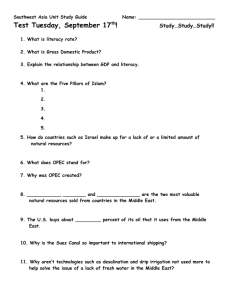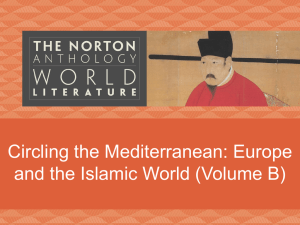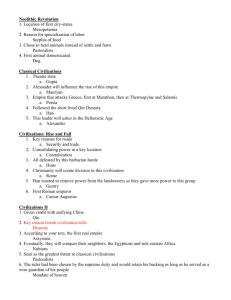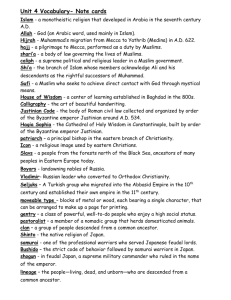Course: United States History I (1763-1877)
advertisement
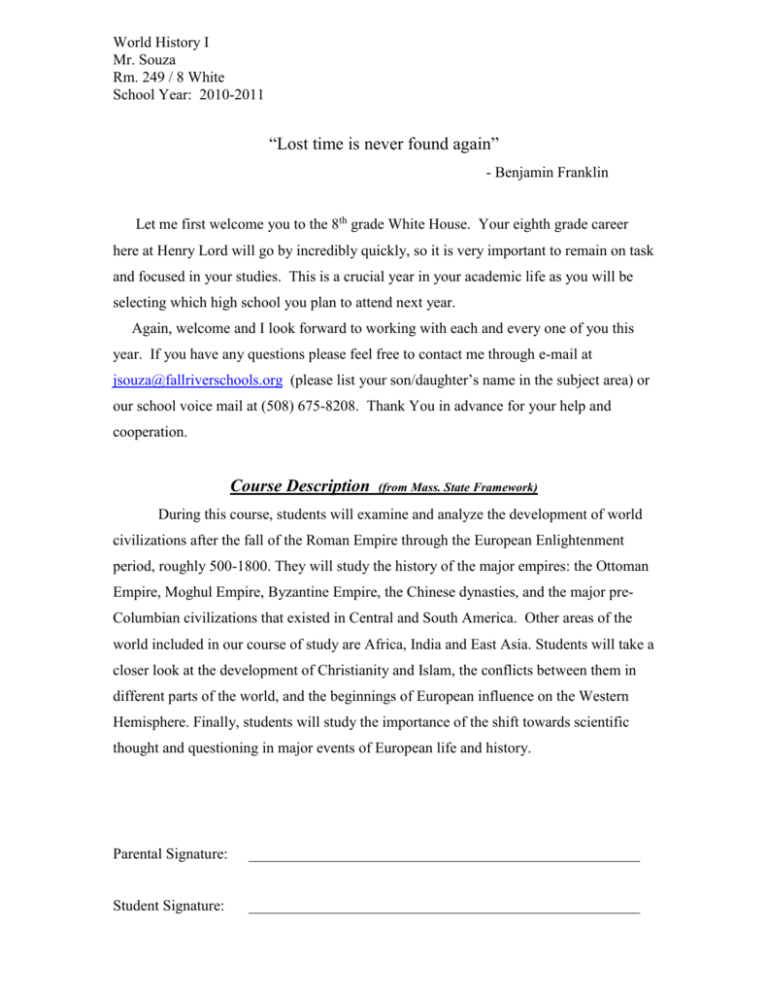
World History I Mr. Souza Rm. 249 / 8 White School Year: 2010-2011 “Lost time is never found again” - Benjamin Franklin Let me first welcome you to the 8th grade White House. Your eighth grade career here at Henry Lord will go by incredibly quickly, so it is very important to remain on task and focused in your studies. This is a crucial year in your academic life as you will be selecting which high school you plan to attend next year. Again, welcome and I look forward to working with each and every one of you this year. If you have any questions please feel free to contact me through e-mail at jsouza@fallriverschools.org (please list your son/daughter’s name in the subject area) or our school voice mail at (508) 675-8208. Thank You in advance for your help and cooperation. Course Description (from Mass. State Framework) During this course, students will examine and analyze the development of world civilizations after the fall of the Roman Empire through the European Enlightenment period, roughly 500-1800. They will study the history of the major empires: the Ottoman Empire, Moghul Empire, Byzantine Empire, the Chinese dynasties, and the major preColumbian civilizations that existed in Central and South America. Other areas of the world included in our course of study are Africa, India and East Asia. Students will take a closer look at the development of Christianity and Islam, the conflicts between them in different parts of the world, and the beginnings of European influence on the Western Hemisphere. Finally, students will study the importance of the shift towards scientific thought and questioning in major events of European life and history. Parental Signature: ____________________________________________________ Student Signature: ____________________________________________________ World History I Course Outcomes Textbook Used: Holt, Rinehart and Winston, World History Unit 1: The Emergence and Expansion of Islam to 1500 (Sept.-Oct.) [3-4 weeks] Students will: Illustrate on a map the beginnings and expansion of Islam. Describe the many facets of Islamic belief. Analyze the political, social, economic and religious effects of Islamic expansion. Analyze Islamic influence and achievements in architecture, mathematics, philosophy and science. Describe the expansion of the Ottoman Empire in the 15th and 16th centuries. Unit 2: African History to 1800 (Oct.-Nov.) [3-4 weeks] Students will: Describe the native religious practices observed by early Africans before contact with Islam and Christianity. Explain how extended family/kinship and tribal relationships have shaped native African cultures, and their effects on the development of African countries. Describe the different ways in which Islam and Christianity influenced native African cultures. Identify the locations, time periods as well as the political and economic aspects of the Ghana, Mali, and Songhay empires. Describe important political and economic aspects of the African empires Describe the development and effects of the trans-African slave trade to the Middle East from the 8th century on, and the trans-Atlantic slave trade to the Western Hemisphere from the 16th century on : Unit 3: Indian History to 1800 (Nov.) [3-4 weeks] Students will: Describe important economic, political, and religious developments in Indian history to 1800. A. the origins of Indian civilization in the Indus Valley B. the evolution and central principles of Hinduism C. the development of the caste system D. the influence of Islam and the rise and fall of the Moghul empire E. artistic and intellectual achievements, including the development of a decimal system Describe the growth of British influence in India and the emergence of the British Raj. Describe the expansion of Islam into India from the 13th through the 17th century, the role of the Mongols, the rise and fall of the Moghul Empire, and the relationship between Muslims and Hindus. Unit 4: History of China, Japan and Korea to 1800 (Dec.-Jan.) [5-6 weeks] Students will: Summarize the major reasons for the continuity of Chinese civilization through the 19th century. A. the role of kinship and Confucianism in maintaining order and hierarchy B. the political order established by the various dynasties that ruled China C. the role of civil servants/scholars in maintaining a stable political and economic order Describe the growth of commerce and towns in China and the importance of agriculture to the development of the Chinese economy to 1800, including the limited role of slavery. Summarize the major economic, political, and religious developments in Japanese history to 1800. A. the evolution of Shinto and Japanese Buddhism B. the development of feudalism C. the rise of the Shoguns and the role of the samurai Describe Japan’s cultural and economic relationship to China and Korea. Describe the influence and consequences of Japanese isolationism to 1800. Explain how Korea has been both a battleground and a cultural bridge between China and Japan. Unit 5: The Medieval Period in Europe to 1500 (Jan.-Feb.) [3-4 weeks] Students will: Illustrate the location of the Byzantine Empire. Analyze the major economical, political and social developments in medieval Europe. Examine the importance of the developing medieval English legal system and its effect on future democratic procedures. Unit 6: The Encounters between Christianity and Islam to 1500 (Feb.-Mar.) [2-3 weeks] Students will: Describe the religious and political origins of conflict between Islam and Christianity (the European Crusades against Islam in the 11th, 12th, and 13th centuries). Describe the rise of the Ottoman Empire in the 14th and 15th centuries. Describe the decline of Muslim rule in the Iberian Peninsula and the subsequent rise of Spanish and Portuguese kingdoms after the Reconquest in 1492. Unit 7: Renaissance and the Reformation in Europe (Mar.) [3 weeks] Students will: Describe the origins and development of the Renaissance, including the influence and accomplishments of Machiavelli, Michelangelo, Leonardo da Vinci, Raphael, Shakespeare, and Johannes Gutenberg. Describe origins and effects of the Protestant Reformation. A. the reasons for the growing discontent with the Catholic Church, including the main ideas of Martin Luther and John Calvin B. the spread of Protestantism across Europe, including the reasons and consequences of England’s break with the Catholic Church C. the consolidation of royal power Explain the purposes and policies of the Catholic Counter-Reformation, including the influence and ideas of Ignatius Loyola. Explain the role of religion in the wars among European nations in the 15th and 16th centuries. Analyze the roles of the Renaissance, Reformation on European society. Unit 8: Scientific Revolution (Apr.) [1-2 weeks] Students will: Summarize how the Scientific Revolution and the scientific method led to new theories of the universe and describe the accomplishments of leading figures of the Scientific Revolution, including Bacon, Copernicus, Descartes, Galileo, Kepler, and Newton. Unit 9: The Origins of European Western Expansion and the Civilizations of Central and South America (Apr.) [2-3 weeks] Students will: Explain the reasons for European expansion westward and its effects on the growth of commerce and the development of the trans-Atlantic slave trade Identify the three major pre-Columbian civilizations that existed in Central and South America (Maya, Aztec, and Inca) and their locations. Describe Mayan, Aztec and Incan political structures, religious practices, economies, art and architecture, and use of slaves Identify the major economic, political, and social effects of the European colonial period in South America Unit 10: Enlightenment in Europe (May) [2 weeks] Students will: Describe the concept of Enlightenment in European history and describe the accomplishments of major Enlightenment thinkers, including Diderot, Kant, Locke, Montesquieu, Rousseau, and Voltaire. Explain how the Enlightenment contributed to the growth of democratic principles of government and a stress on reason and progress. Analyze the roles of the Scientific Revolution, Enlightenment, and the Industrial Revolution on European society. Unit 11: Beginnings of American Democracy (May – June) [5-6 weeks] Outline and analyze key events that pushed the American colonists towards rebellion. Describe how the colonists organized their resistance to British policies and rule. Summarize the reasons for America declaring its independence. Examine the establishment of a new government, the Articles of Confederation. Analyze the reasons for the new nation to purposely make a weak federal government. Explain how the Constitutional Convention came about. Analyze how conflicts and compromise helped shape the Constitution. Explain how the Constitution became the “Law of the Land.” Analyze the structure of the government (branches, Bill of Rights, etc). Assessment Students will be assessed in a variety of ways. It is required that every student maintains an up to date notebook. Students will be expected to participate in class discussions as well as in group activities. It is imperative that every student completes all homework assignments in a timely manner. By being successful in these areas students will be building a strong sense of responsibility, community and commitment. During each unit of study, students will take the traditional quizzes and tests. Finally, when applicable, a unit of study may have either a project or culminating activity, which shall be counted as a test grade, to assure that the material covered was fully understood and learned. Course Materials Students are expected to come to class prepared and ready to learn. This means that each student must have a pen or pencil with them everyday. They are expected to bring their notebook with them to class everyday as well. Textbooks are located in class. Classroom Expectations / Discipline Policy 1. Practice respectful behavior at all times. (actions, language, etc.) 2. Come to class prepared to learn. (attitude, pen, pencil, notebook, etc.) 3. Upon arrival to class, immediately start working on your “activator” or “question of the day”. 4. Raise your hand before speaking. 5. No Gum or Food allowed in class!! Grading Policy Test 30% (at appropriate times within each unit of study) Quiz 15% Homework 20% (3-4 each week) Notebook 20% (checked every 5 weeks) Class work/participation 15% ** Tests and quizzes will consist of, but not be limited to, multiple choice questions, open response, maps and graphic organizers. ** Projects/Culminating Activities will be selected from historical people of study, historical events and/or historical themes. * If a student is absent on the day of a test or quiz, he/she will be given five school days to make up the test or quiz before or after school. If a student does not request a make up after the allotted time the grade will become a “0”. * If a student is absent when a homework assignment is due, he/she is expected to turn it in on the day of his/her return to school. * If a student is absent on the day a project/report or notebook is due, he/she is expected to turn it in on the day of his/her return to school. Work not submitted in a timely manner will not be accepted!!
